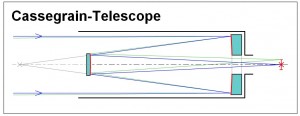I saved this tweet from Jodcaster Jennifer Gupta because it made me feel good. Sometimes it’s easy to understand WHAT and instrument and WHY it does it, but the HOW can be completely incomprehensible (more so to me than Ms. Gupta, I suspect).
The Large Area Telescope (LAT) to which this tweet refers is the primary instrument on the Fermi Gamma Ray Space Telescope spacecraft.* As the name of the satellite suggests, the Fermi instruments are directed toward detecting gamma radiation sources. Gamma radiation (aka gamma rays) is electromagnetic radiation with a high frequency/short wavelength. In fact, gamma rays are the highest-energy forms of light in the electromagnetic spectrum. The Fermi satellite follows decades of gamma ray detection and analysis through various means by NASA, but it is unique in that it’s the first instrument to survey the entire sky every day for gamma radiation.
The entire sky? Yes, but in search of some more specific targets: blazars, active galaxies, gamma-ray bursts, neutron stars, cosmic rays, supernova remnants, our own galaxy and solar system, and….wait for it….dark matter!
The LAT is used to detect gamma rays using a process called “pair production,” which is governed by Einstein’s statement of the equivalence of energy and matter (E=mc2). Gamma rays are pure energy. When gamma radiation hits the tungsten detector in the Large Area Telescope, it creates a pair of subatomic particles, one electron and one positron. Silicon tracking detectors project the path of these particles backward to the source of the gamma ray. A third detector, the calorimeter, measures the energy of the particles, which is dependent on the energy of the gamma ray.
The gamma rays detected and measured by the LAT come from a variety of objects—different kinds of active galactic nuclei, for example, like radio galaxies, Seyfert galaxies, quasars, and blazars. But the science team behind the LAT expect blazars to be the greatest producers of detectable/measurable gamma rays. Blazars (blazing quasi-stellar objects) are very compact quasars (quasi-stellar objects) with supermassive black holes at the center of elliptical galaxies. Blazars are very high energy—maybe the highest energy objects in the universe—and their jets appear to be aimed toward earth. Analysis of these jets with the Fermi instruments should tell us more about the origins and structure of the universe. As GLAST Interdisciplinary Scientist Charles Dermer of the Naval Research Laboratory in Washington, D.C., once noted “When GLAST detects a blazar, it is monitoring violent activity from a black hole taking place in the distant past. Understanding gamma rays from these sources is a form of black hole archeology that reveals the high-energy history of our Universe.”
The LAT is at least 30 times more sensitive than any other instrument sent into space for measuring gamma rays, so it’s no wonder that the results have been so phenomenal. Although the write-ups of the results aren’t directed toward a popular audience (you can read some of the recent publications at arXiv.org), occasionally the science team finds something so unusual it makes the daily news report. For instance, earlier this year, the LAT detected two gamma-ray flares in the Crab Nebula. I loved the press release for that discovery, which noted the science team was “dumbfounded” by the high-energy flares. Can’t you see a room full of post-docs in ratty t-shirts and jeans staring at their computer screens, saying, “WTF? I seriously need to get more sleep!”?
If you want to delve into the Fermi spacecraft in more detail without battling through a course in particle physics first, NASA has a fantastic guide on the subject for science writers. It’s almost 50 pages long, but so interesting, I have to recommend it for reading at dinner table.
*The spacecraft was originally named the Gamma-Ray Large Area Space Telescope (GLAST), but was renamed for Enrico Fermi in August 2008.







 -fr
-fr kt
kt )
)